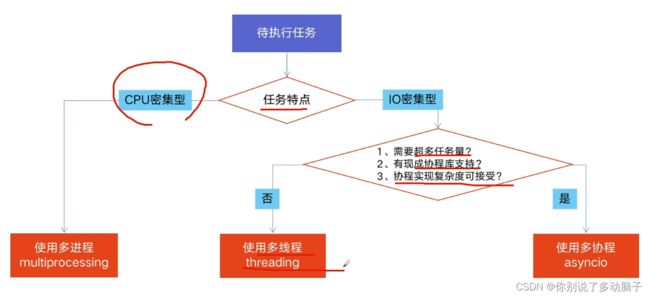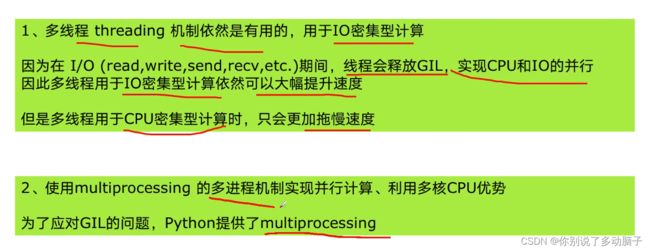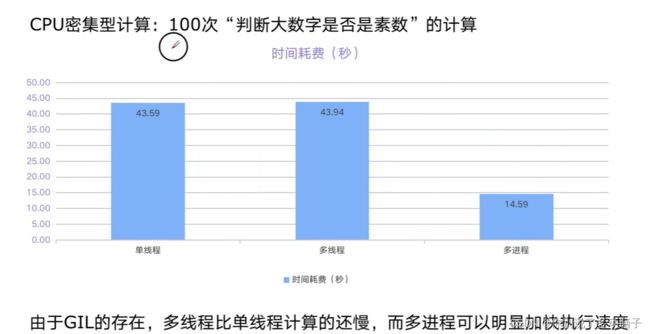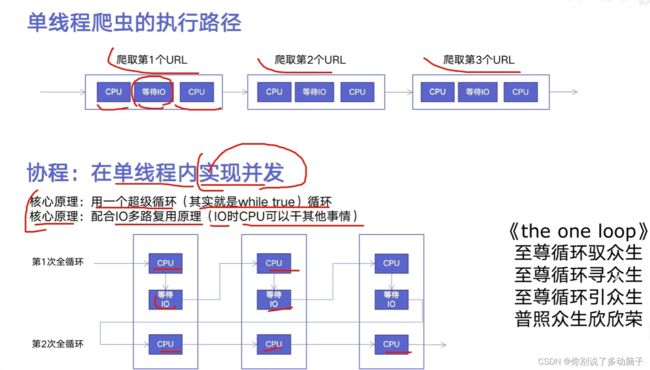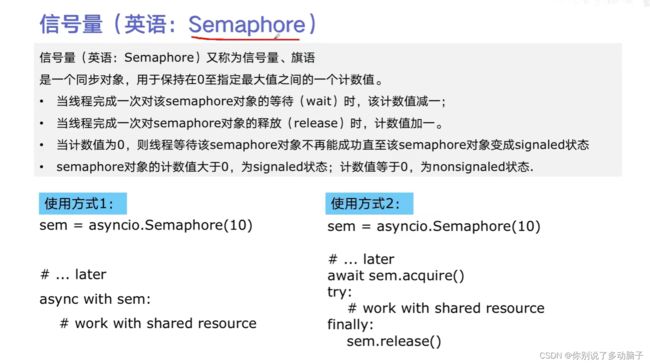【Python案例】(十)多线程、多进程、多协程加速程序
文章目录
- P1 Python并发编程简介
-
- 一、具体应用:
- 二、几种方式的联系与Python的支持:
-
- 1)对比
- 2)python的支持
- P2 怎样选择多线程、多进程、多协程
-
- 一、CPU密集型计算、IO密集型计算
-
- CPU密集型(CPU-bound):
- I/O密集型(I/O bound):
- 二、多线程、多进程、多协程的对比:
-
- 1、Python并发编程有三种方式:
- 2、 对比
-
- 1)多进程Process(multiprocessing)
- 2)多线程Thread(threading)
- 3)多协程Coroutine(asyncio)
- 三、怎样根据任务选择对应技术?
- P3:全局解释器锁GIL
-
- 一、Python速度慢的两大原因
- 二、GIL是什么?
- 三、为什么有GIL这个东西?
- 四、怎么规避GIL带来的限制
- P4:使用多线程加速程序Python代码
-
- 一、Python创建多线程的方法
- P5:Python实现生产者消费者爬虫
-
- 一、多组件的Pipeline技术架构
- 二、代码实现
- P6:线程安全问题以及Lock解决方案
-
- 一、线程安全概念介绍
- 二、Lock用于解决线程安全问题
- 三、实力代码演示问题以及解决方案
- P7: 线程池ThreadPoolExecututor
-
- 一、线程池的原理
- 二、使用线程池的好处
- 三、ThreadPoolExecutor的使用语法
- 四、使用线程池改造爬虫程序
- P8:使用线程池在Web服务中实现加速
-
- 一、Web服务的架构以及特点
- 二、使用线程池ThreadPoolExecutor加速
- 三、代码用Flask实现Web服务并实现加速
- P9:多进程multiprocessing模块加速程序的运行
-
- 一、有了多线程threading,为什么还要用多进程multiprocessing
- 二、多进程multiprocessing知识梳理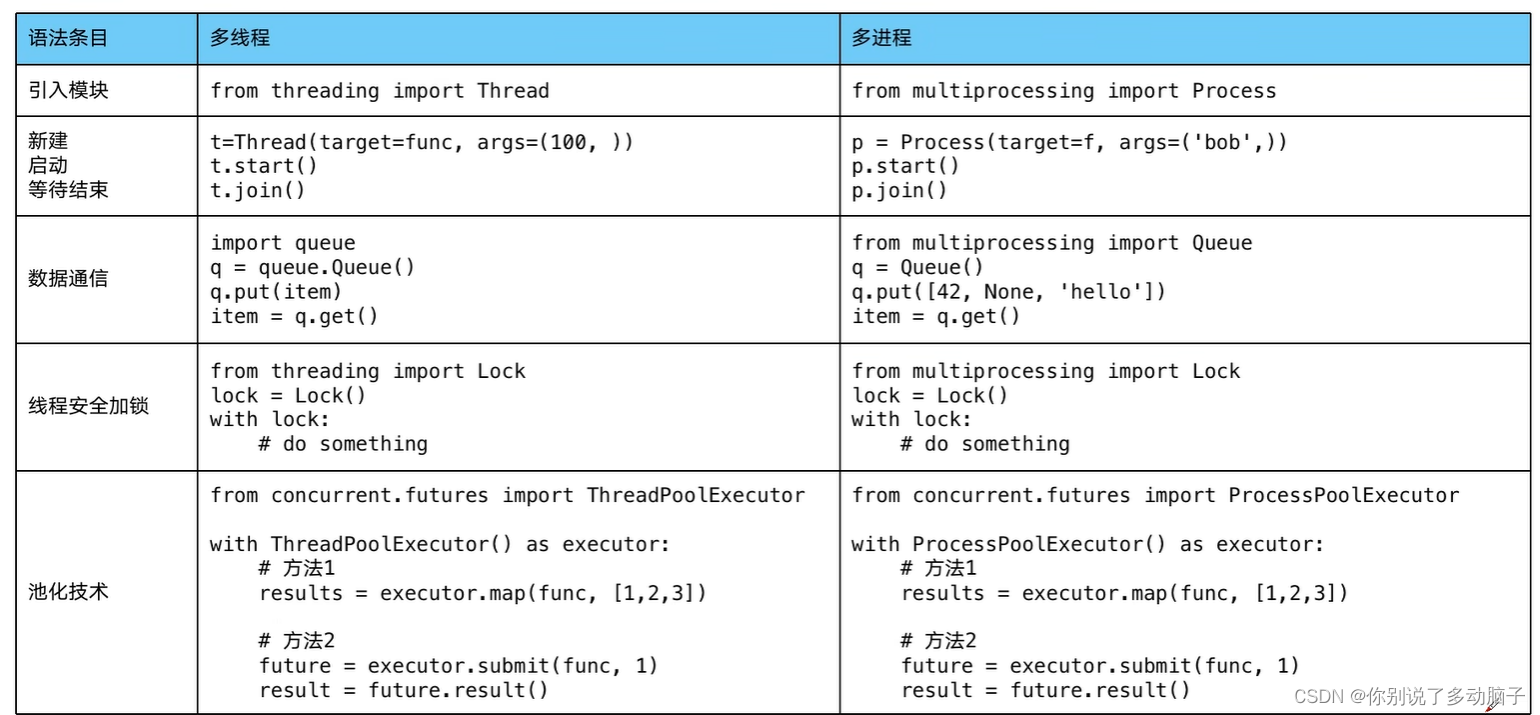
- 三、代码实战:单线程、多线程、多进程对比CPU密集计算速度
- P10: Python在Flask服务中使用多进程池加速程序运行
- P11:异步IO实现并发爬虫
- P12:在异步IO中使用信号量控制爬虫并发度
P1 Python并发编程简介
一、具体应用:
- 并发爬虫,同时进行爬取
- APP应用,每次打开页面需要3秒,异步并发提升到200毫秒
二、几种方式的联系与Python的支持:
1)对比
单线程串行(不加改造的程序)>>>多线程并发(threading)>>>多CPU并行(multiprocessing)>>>多机器并行(hadoop/hive/spark)
- 多线程并发,是在IO执行阶段,CPU可以运行,还是单CPU运行的方式;
- 多CPU并行:多核多CPU运行
- 多机器并行:大数据时代
2)python的支持
多线程:threading,利用CPU和IO可以同时执行的原理,让CPU不会干巴巴等待IO完成
多进程:multiprocessing,利用多核CPU的能力,真正的并行执行任务
异步IO:asyncio,在单线程利用CPU和IO同时执行的原理,实现函数异步执行
使用Lock对资源枷锁,防止冲突访问(多线程和多进程同时访问一个文件会冲突,如果锁起来就可以有序访问)
使用Queue实现不同线程/进程之间的数据通信,实现生产者-消费者模式
使用线程池Pool/进程池Pool,简化线程/进程的任务提交、等待结束、获取结果
使用subprocess启动外部程序的进程,并进行输入输出交互
P2 怎样选择多线程、多进程、多协程
一、CPU密集型计算、IO密集型计算
CPU密集型(CPU-bound):
CPU密集型也叫计算密集型,是指I/O在很短的时间就可以完成,CPU需要大量的计算和处理,特点是CPU占用率相当高。
例如:解压缩、加密解密、正则表达式搜索
I/O密集型(I/O bound):
IO密集型指的是系统运作大部分的状况是CPU在等I/O(硬盘 /内存)的读/写操作,CPU占用率仍然较低。
例如:文件处理程序、网络爬虫程序、读写数据库程序
二、多线程、多进程、多协程的对比:
1、Python并发编程有三种方式:
多线程Thread、多进程Process、多协程Coroutine
2、 对比
关系:一个进程中,可以启动N个线程;一个线程中,可以启动N个协程
1)多进程Process(multiprocessing)
- 优点:可以利用多核CPU并行运算
- 缺点:占用资源最多、可启动数目比线程少
- 适用于:CPU密集型计算
2)多线程Thread(threading)
- 优点:相比进程、更轻量级、占用资源少
- 缺点:
- 相比进程:多线程只能并发执行,不能利用多CPU(GIL)
- 相比协程:启动数目有限制,占用内存资源,有线程切换开销
- 适用于:IO密集型计算、同时运行的任务数目要求不多
3)多协程Coroutine(asyncio)
- 优点:内存开销最少、启动协程数量最多
- 缺点:支持的库有限制(aiohttp vs requests(不支持协程))、代码实现复杂
- 适用于:IO密集型计算、需要超多任务运行、但有现成库支持的场景
三、怎样根据任务选择对应技术?
P3:全局解释器锁GIL
一、Python速度慢的两大原因
- 相比C/C++/JAVA,Python确实慢,在一些特殊场景下,Python比C++慢100~200倍
- 由于速度慢的原因,很多公司的基础架构代码依然用C/C++开发;比如各大公司阿里/腾讯/快手的推荐引擎、搜索引擎、存储引擎等底层对性能要求高的模块
1)动态类型语言,边解释边执行
2)GIL的存在,使得python无法利用多核CPU并发执行
二、GIL是什么?
全局解释器锁(Global Interpreter Look,缩写GIL)是计算机程序设计语言解释器用于同步线程的一种机制,它使得任何时刻仅有一个线程在执行。即便在多核心处理器上,使用GIL。
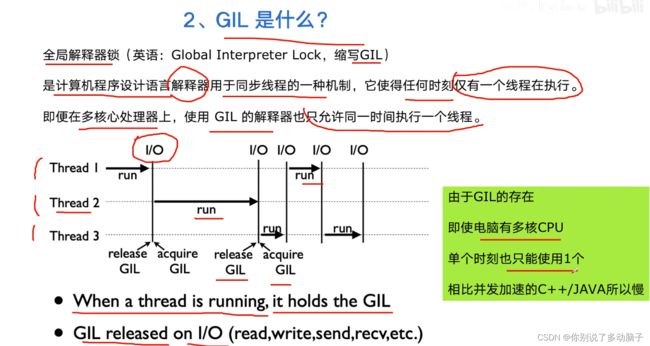
三、为什么有GIL这个东西?
- 简而言之:Python设计初期,为了规避并发问题引入了GIL,现在想去却去不掉了!
- GIL确实有好处:简化了Python对共享资源的管理。
四、怎么规避GIL带来的限制
P4:使用多线程加速程序Python代码
一、Python创建多线程的方法
1. 准备一个函数
def my_func(a,b):
dp_craw(a,b)
2. 怎样创建一个线程
import threading
t = threading.Thread(target = my_func, args = (100,200) # args是函数的参数
3. 启动线程
t.start()
4. 等待结束
t.join()
- 元组要加逗号,否则就是个字符串
具体案例
- 在同目录下创建一个blog_spider.py文件
import requests
urls = [
f"https://www.cnblogs.com/#p{page}"
for page in range(1, 51)
]
def craw(url):
r = requests.get(url)
print(url, len(r.text))
import blog_spider
import threading
def single_thread():
print("single_thread begin")
for url in blog_spider.urls:
blog_spider.craw(url)
print("single_thread end")
def multi_thread():
print("multi_thread begin")
threads = []
for url in blog_spider.urls:
threads.append(
threading.Thread(target=blog_spider.craw, args=(url,)) #元组要加逗号,否则就是个字符串
)
for thread in threads:
thread.start()
for thread in threads:
thread.join()
print("multi_thread end")
P5:Python实现生产者消费者爬虫
一、多组件的Pipeline技术架构
复杂的事情一般都不会一下子做完,而是会分很多中间步骤一步步完成


二、代码实现
- blog_spider.py假
import requests
from bs4 import BeautifulSoup
urls = [
f"https://www.cnblogs.com/#p{page}"
for page in range(1, 51)
]
def craw(url):
r = requests.get(url)
return r.text
def parse(html):
# class="post-item-title"
soup = BeautifulSoup(html, "html.parser")
links = soup.find_all("a", class_="post-item-title")
return [(link["href"]) for link in links]
- 复杂的爬虫可以分为很多模块,每个模块可以用不同的线程组处理
import queue
import blog_spider
import time
import random
import threading
def do_craw(url_queue:queue.Queue, html_queue: queue.Queue):
while True:
html = url_queue.get()
html = blog_spider.craw(url)
html_queue.put(html)
print(threading.current_thread().name, f"craw{url}",
"url_queue.size=", url_queue.qsize())
time.sleep(random.randint(1,2))
def do_parse(html_queue:queue.Queue, fout):
while True:
html = html_queue.get()
results = blog_spider.parse(html)
for result in results:
fout.write(str(result) + "\n")
print(threading.current_thread().name, f"results.size",
len(results),"html_queue.size=", html_queue.qsize())
time.sleep(random.randint(1, 2))
if __name__ == "__main__":
url_queue = queue.Queue()
html_queue = queue.Queue()
for url in blog_spider.urls:
url_queue.put(url)
for idx in range(3):
t = threading.Thread(target=do_craw, args = (url_queue, html_queue),
name = f"craw{idx}")
t.start()
fout = open("o2.data.txt", "w")
for idx in range(2):
t = threading.Thread(target=do_parse, args=(html_queue, fout),
name=f"parse{idx}")
t.start()
P6:线程安全问题以及Lock解决方案
一、线程安全概念介绍
- 线程安全指某个函数、函数库在多线程环境中被调用时,能够正确地处理多个线程之间地共享变量,使程序功能正确完成。
- 同理,线程不安全是由于线程地执行随时会发生切换,就造成了不可预料地结果,出现线程不安全
例如,银行取钱问题:
def draw(account, amount):
if account.balance >= amount:
account.balance -= amount
二、Lock用于解决线程安全问题
为解决上述问题,需要对代码进行加锁,有以下两种方法:
(先获取锁,然后执行代码)
- 用法1:try-finally 模式
import threading
lock = threading.Lock()
lock.acquire()
try:
# do something
finally:
lock.release()
- 用法2: with模式
import threading
lock = threading.Lock()
with lock:
#do something
三、实力代码演示问题以及解决方案
- 会出现-600余额的情况,这是有问题的
import threading
import time
**lock = threading.Lock()**
class Account:
def __init__(self, balance):
self.balance = balance
def draw(account, amount):
**with lock:**
if account.balance >= amount:
time.sleep(0.1)
print(threading.current_thread().name, "取钱成功")
account.balance -= amount
print(threading.current_thread().name,
"余额", account.balance)
else:
print(threading.current_thread().name,
"取钱失败,余额不足")
if __name__ == "__main__":
account = Account(1000)
ta = threading.Thread(name="ta", target=draw,args=(account, 800))
tb = threading.Thread(name="tb", target=draw,args=(account, 800))
ta.start()
tb.start()
需要对上面代码进行简要修改,修改部分标粗
P7: 线程池ThreadPoolExecututor
一、线程池的原理
新建线程系统需要分配资源、终止线程系统需要回收资源;如果可以重用线程,则可以减去新建/终止的开销。这样就引出了线程池。
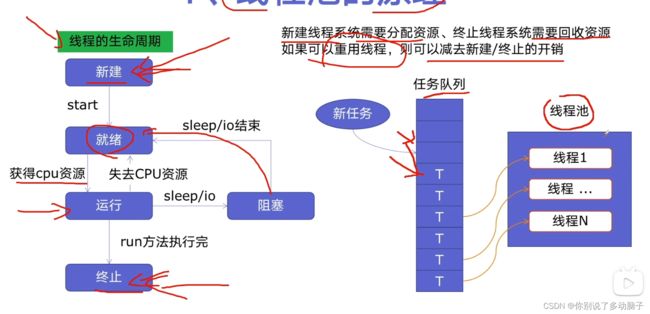
二、使用线程池的好处
- 提升性能:因为减去了大量新建、终止线程的开销,重用了线程资源;
- 适用场景:适合处理突发性大量请求或大量线程完成任务、但实际任务处理时间较短
- 防御功能:能有效避免系统因为创建线程过多,而导致系统负荷过大相应变慢等问题
- 代码优势:使用线程池的语法比自己新建线程执行线程更加简洁
三、ThreadPoolExecutor的使用语法
两种用法:
- 用法1:map函数,(简单)注意map的结果和入参是顺序对应的
from concurrent.futures import ThreadPoolExecutor, as_completed
with ThreadPoolExecutor() as pool:
results = pool.map(craw,urls) # map传入函数和参数列表
for result in results:
print(result)
遇到多个参数的函数需要线程池支持时,依次并列往后就行,不用生成元组:
with ThreadPoolExecutor() as pool:
# results = pool.map(run_noerror,arg)
results = pool.map(run_noerror, titles, start_list, end_list) # 多余的参数就依次往后列出就行
- 用法2:future模式,(强大)注意如果用as_completed顺序是不定的
from concurrent.futures import ThreadPoolExecutor, as_completed
with ThreadPoolExecutor() as pool:
futures = [pool.submit(craw, url) for url in urls]
for future in futures: # 第一种这种会按照url对应的顺序依次获取结果
print(future.result())
for future in as_completed(futures): # 返回先执行完的任务,无顺序
print(future.result())
四、使用线程池改造爬虫程序
创建python文件04.thread_pool.py如下:
import concurrent.futures
import blog_spider
# craw 方法1
with concurrent,futures.ThreadPoolExcecutor() as pool:
htmls = pool.map(blog_spider.craw, blog_spider.urls)
htmls = list(zip(blog_spider.urls, htmls))
for url, html in htmls:
print(url, len(html))
print("craw over")
# parse 方法2
with concurrent.futures.ThreadPoolExecutor() as pool:
futures = {}
for url, html in htmlsL
future = pool.submit(blog_spider.parse, html)
futures[future] = url
for future, url in futures.items(): # 有顺序的方式
print(url, future.result())
for future in concurrent.futures.as_completed(futures): # 无顺序的方法
url = futures[future]
print(url, future.result())
P8:使用线程池在Web服务中实现加速
一、Web服务的架构以及特点
Web后台服务的特点:
- Web服务对响应时间要求非常高,比如要求200MS返回
- Web服务有大量的依赖IO操作的调用,比如磁盘文件、数据库、远程API
- Web服务经常需要处理几万人、几百万人的同时请求
二、使用线程池ThreadPoolExecutor加速
使用线程池ThreadPoolExecutor的好处:
- 方便的将磁盘文件、数据库、远程API和IO调用并发执行;
- 线程池的线程数目不会无限创建(导致系统挂掉),具有防御功能
三、代码用Flask实现Web服务并实现加速
创建05.flask_thread_pool.py的python文件
import flask
import json
import time
from concurrent.futures import ThreadPoolExecutor
app = flask.Flask(__name__)
pool = ThreadPoolExecutor()
def read_file():
time.sleep(0.3)
return "file result"
def read_db():
time.sleep(0.1)
return "db result"
def read_api():
time.sleep(0.2)
return "df result"
@app.route("/")
def index():
result_file = pool.submit(read_file)
result_db = pool.submit(read_bd)
result_api = pool.submit(read_api)
return json.dumps({
"result_file": result_file.result(),
"result_db": result_db.result(),
"result_api": result_api.result()
})
if __name__ == "__main__":
app.run()
P9:多进程multiprocessing模块加速程序的运行
一、有了多线程threading,为什么还要用多进程multiprocessing
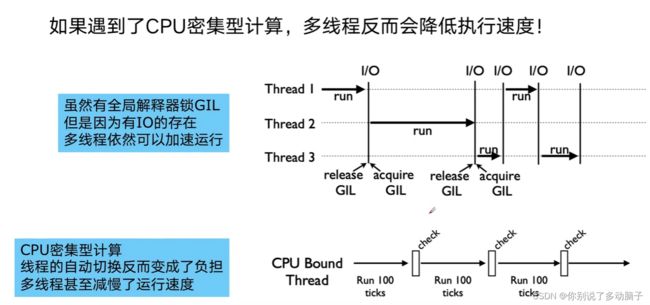
multiprocessing模块就是python为了解决GIL缺陷引入的一个模块,原理是用多进程在多CPU上并行执行。
二、多进程multiprocessing知识梳理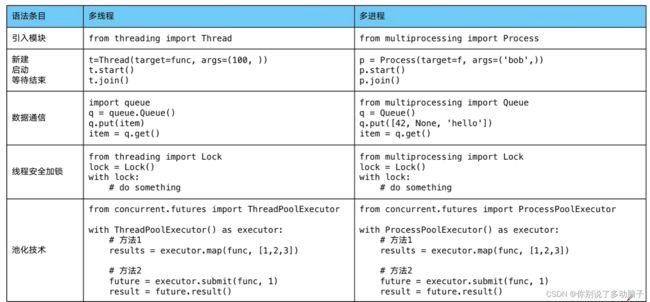
三、代码实战:单线程、多线程、多进程对比CPU密集计算速度
import math
import concurrent.futures import ThreadPoolExecutor, ProcessPoolExecutor
import time
PRIMES = [112272535095293] * 100
def is_prime():
if n<2:
return False
if n == 2:
return True
if n % 2 == 0:
return False
sqrt_n = int(math.floor(math.sqrt(n)))
for i in range(3, sqrt_n + 1,2):
if n%i ==0:
return False
return True
# 单线程
def single_thread():
for number in PRIMES:
is_prime(number)
def multi_thread():
with ThreadPoolExecutor as pool:
pool.map(is_prime,PRIMES)
def multi_process():
with ProcessPoolExceutor() as pool:
pool.map(is_prime, PRIMES)
if __name__ = "__main__":
start = time.time()
single_thread()
end = time.time()
print("single_thread,cost:", end - start, "seconds")
start = time.time()
multi_thread()
end = time.time()
print("multi_thread,cost:", end - start, "seconds")
start = time.time()
multi_process()
end = time.time()
print("multi_process,cost:", end - start, "seconds")
P10: Python在Flask服务中使用多进程池加速程序运行
创建python文件07.process_pool.py如下:
import flask
from concurrent.futures import ProcessPoolExecutor
import json
import math
app = flask.Flask(__name__)
def is_prime():
if n<2:
return False
if n == 2:
return True
if n % 2 == 0:
return False
sqrt_n = int(math.floor(math.sqrt(n)))
for i in range(3, sqrt_n + 1,2):
if n%i ==0:
return False
return True
@app.route("/is_prime/" )
def api_is_prime(numbers):
number_list = [int(x) for x in numbers.split(",")]
results = process_pool.map(is_prime(),number_list)
return json.dumps(dict(zip(number_list,results)))
if __name__ == "__main__":
process_pool = ProcessPoolExecutor()
app.run()
P11:异步IO实现并发爬虫
import asyncio
#获取事件循环
loop = asyncio.get_event_loop()
# 定义协程
async def myfunc(url):
await get_url(url)
# 创建task列表
tasks = [loop.create_task(myfunc(url)) for url in urls]
# 执行爬虫事件列表
loop.run_until_complete(asyncio.wait(tasks))
import asyncio
import aiohttp
import blog_spider
async def async_craw(url):
async with aiohttp.ClientSession() as session:
async with session.get(url) as resp:
result = await resp.text()
print(f"craw url: {url},{len(result)}")
loop = asyncio.get_event_loop()
tasks = [
loop.create_task(async_craw(url))
for url in blog_spider.urls
]
import time
start = time.time()
loop.run_until_complete(asyncio.wait(tasks))
end = time.time()
print(start-end)
注意:
- 要用在异步IO编程中,依赖的库必须支持异步IO特性
- 在爬虫中,不支持requests库,可以用aiohttp代替
P12:在异步IO中使用信号量控制爬虫并发度
import asyncio
import aiohttp
import blog_spider
semaphore = asyncio.Semaphore(10) # 信号量控制了并发度
async def async_craw(url):
async with semaphore:
print("craw url:", url)
async with aiohttp.ClientSession() as session:
async with session.get(url) as resp:
result = await resp.text()
await asyncio.sleep(5)
print(f"craw url: {url},{len(result)}")
loop = asyncio.get_event_loop()
tasks = [
loop.create_task(async_craw(url))
for url in blog_spider.urls
]
import time
start = time.time()
loop.run_until_complete(asyncio.wait(tasks))
end = time.time()
print(start-end)
视频来源:https://www.bilibili.com/video/BV1bK411A7tV?p=1&vd_source=63b8ded929e53ceb23c48c6ca09fa194
